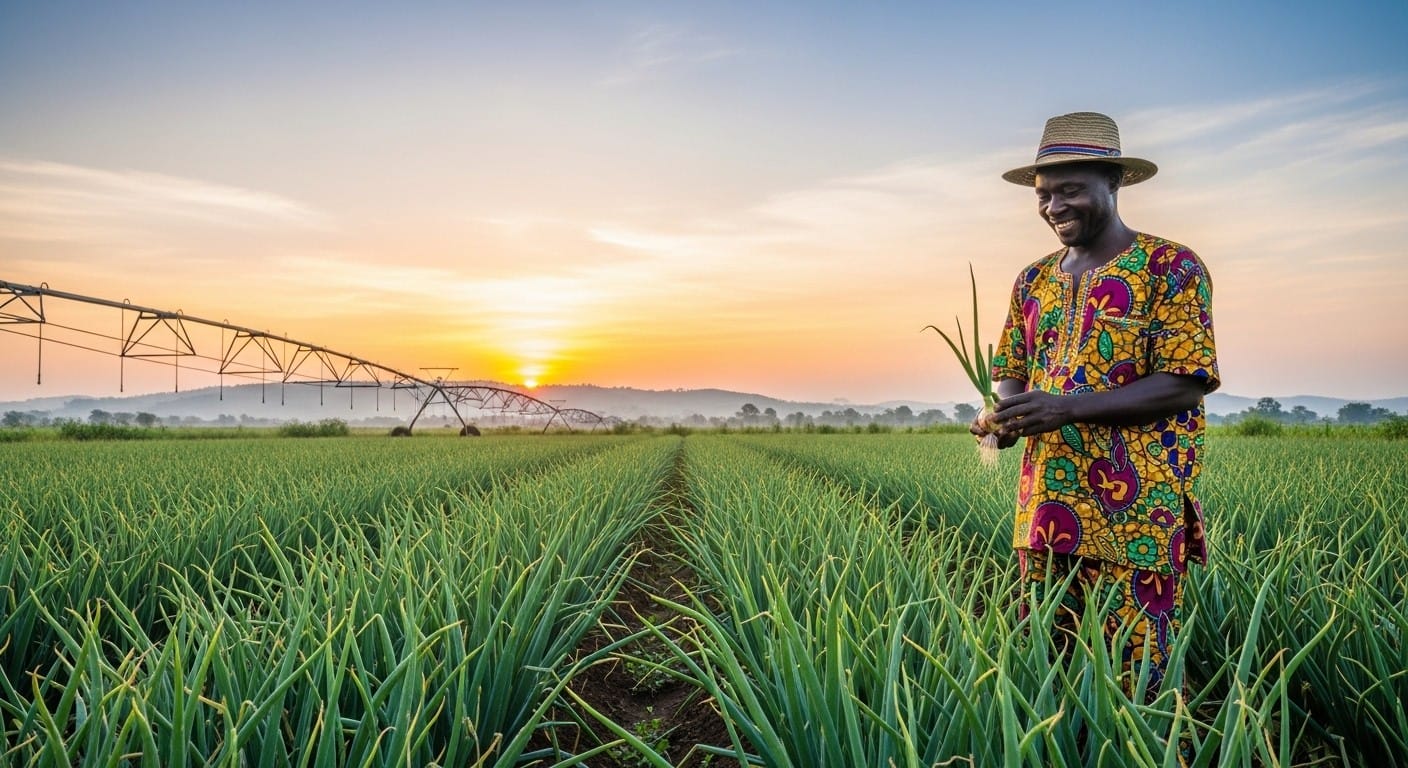How to Start a Profitable Onion Farm in Ghana: A Step-by-Step Guide
Onion farming represents a significant and often underestimated agricultural opportunity in Ghana. With high local demand and the potential for substantial returns, it’s an attractive venture for savvy entrepreneurs. Based on field data and agricultural research, a well-managed one-acre onion farm can generate revenues as high as GHS 75,000 every three to four months. This guide provides a complete blueprint for entrepreneurs looking to start a profitable onion farm in Ghana, covering everything from initial costs to overcoming common challenges.
Why Invest in Onion Farming in Ghana?
The demand for onions in Ghana consistently outstrips local supply, leading to reliance on imports. This gap presents a clear market opportunity. Urban vegetable production, including onions, is a proven driver of food security and provides a robust source of income. Research shows that irrigated vegetable farming can be two to three times more profitable than traditional rain-fed agriculture, making it a powerful tool for wealth creation.
- High Profit Margins: Onions, particularly spring onions and bulb varieties, command good prices and offer excellent revenue potential.
- Strong Market Demand: Onions are a staple ingredient in Ghanaian cuisine, ensuring consistent demand from households, restaurants, and fast-food vendors.
- Job Creation: A successful farm creates employment opportunities, contributing to the local economy.
- Quick Turnaround: Onions have a relatively short growth cycle (3-4 months), allowing for quick returns on investment.
Understanding the Financials: Costs and Potential Profits of Onion Farming in Ghana
To succeed, you need a clear understanding of the investment required and the potential returns. The following table, adapted from research on exotic vegetable production in Ghana, provides an estimated financial breakdown for a one-acre onion farm.
Estimated Costs and Revenue Per Acre (Example)
| Item | Description | Estimated Cost (GHS) |
|---|---|---|
| Total Variable Costs | Costs that change with production level. | ~ GHS 8,000 – 12,000 |
| Land Preparation (Ploughing, harrowing) | GHS 1,500 | |
| Seeds/Seedlings | GHS 2,000 | |
| Fertilizer (NPK, Sulphate of Ammonia) | GHS 2,500 | |
| Pesticides/Herbicides | GHS 800 | |
| Labor (Planting, weeding, harvesting) | GHS 3,000 | |
| Irrigation (Fuel/electricity for water pump) | GHS 1,200 | |
| Total Fixed Costs | One-time or seasonal costs. | ~ GHS 1,500 |
| Tools (Hoes, cutlasses), Rent for equipment | GHS 1,500 | |
| Total Production Cost | Sum of Variable and Fixed Costs | ~ GHS 9,500 – 13,500 |
| Projected Total Revenue | Based on a yield of 8-10 tonnes sold at market price. | ~ GHS 50,000 – 75,000+ |
| Estimated Net Profit | Total Revenue – Total Production Cost | ~ GHS 40,000 – 60,000+ |
Note: These figures are estimates and can vary based on location, season, market conditions, and management practices.
A Complete Step-by-Step Guide to Launching Your Onion Farm
Follow these essential steps to establish and run a successful onion farming business in Ghana.
- Develop a Solid Business Plan: Treat your farm as a business from day one. Your plan should outline your budget, target market, production goals, and marketing strategy.
- Secure Suitable Land: Identify and secure at least one acre of land with good access to a reliable water source. Loamy soils with good drainage are ideal for onions. Address land tenure issues early by securing a lease or ownership to avoid future conflicts.
- Prepare the Land: Clear the land of weeds and debris. Plough and harrow the soil to create a fine tilth, which is essential for good bulb development. Create raised beds to improve drainage and prevent waterlogging.
- Select the Right Onion Variety: Choose varieties well-suited to Ghana’s climate. Popular and high-yielding options include Bawku Red, Galmi, and Texas Grano. Purchase certified seeds from a reputable agro-input dealer.
- Planting: You can plant onions via direct seeding or by transplanting seedlings from a nursery. Transplanting is often preferred as it leads to a more uniform crop stand. Space plants appropriately to allow for proper bulb formation.
- Implement Efficient Irrigation: Onions require consistent moisture, especially during bulb formation. Since the high cost of irrigation is a major challenge, invest in an efficient system like drip irrigation or a well-managed furrow system to conserve water and reduce fuel costs.
- Fertilization and Soil Health: Conduct a soil test to understand its nutrient profile. Apply a balanced NPK fertilizer at planting and top-dress with nitrogen-rich fertilizer like Sulphate of Ammonia during the growing season to boost vegetative growth.
- Manage Pests and Diseases: Proactively manage common onion pests like thrips and diseases like purple blotch. Use integrated pest management (IPM) techniques and apply recommended pesticides judiciously to protect your crop and manage costs.
- Harvesting and Curing: Harvest when the onion tops begin to fall over and yellow. Carefully lift the bulbs from the soil and leave them in the field for a few days to cure. Proper curing is crucial for extending shelf life and preventing post-harvest losses.
- Marketing and Sales Strategy: Don’t wait until harvest to find buyers. Connect with market women, hotels, restaurants, and institutions early. To avoid being a price-taker, form farmer groups to bargain collectively or explore direct-to-consumer sales.
Key Drivers of Profitability
Research on vegetable start a profitable onion farm in Ghana Ghana shows that certain factors significantly impact success. Focus on these areas to maximize your profits:
- Access to Credit: Having capital allows you to purchase quality inputs and hire adequate labor on time. Explore options from financial institutions and government agricultural programs.
- Farming Experience: Experienced farmers are better at implementing improved technologies and managing challenges. If you are new, seek mentorship from established farmers or an extension officer.
- Efficient Labor Management: Labor is a significant cost. Using family labor can reduce expenses, but efficient management of hired labor is key to keeping costs down.
- Education and Knowledge: Farmers with formal education or continuous training tend to be more profitable. Stay informed about modern farming techniques and market trends.
Overcoming Common Challenges in Ghanaian Onion Farming
Every entrepreneur will face obstacles. Being aware of them is the first step to overcoming them.
- High Cost of Inputs: Fertilizers and quality seeds are expensive. Mitigate this by buying in bulk with other farmers or practicing good soil management to improve nutrient efficiency.
- Land Tenure Insecurity: Urban and peri-urban land can be subject to ownership disputes. Secure a formal, long-term lease agreement to protect your investment.
- Pest and Disease Pressure: Pests and diseases can wipe out a crop. Implement a regular scouting and preventative spray program.
- Market Price Dictation: Historically, market women have dictated farm-gate prices. Overcome this by building direct relationships with end-buyers, adding value (e.g., bagging), and negotiating as a collective.
Conclusion: Your Path to a Successful Onion Enterprise
Onion farming in Ghana is far more than a subsistence activity; it is a viable and highly lucrative business venture. While challenges like high input costs and market volatility exist, they can be managed with strategic planning, modern techniques, and a strong business mindset. By following these steps, you can navigate the complexities and build a highly profitable onion farming venture in Ghana, securing your financial future while contributing to the nation’s food supply.











